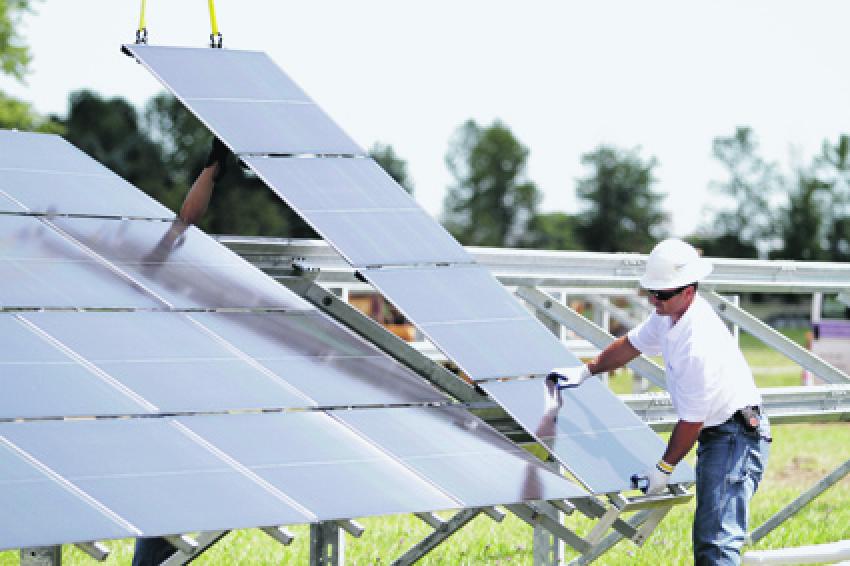A Showcase for Energy Efficiency
Materials solutions help make solar energy a competitive alternative to traditional energy sources
As part of Dow Corning's global research network, the new €9 million Solar Energy Exploration and Development (SEED) research center in Belgium contributes to the development and discovery of new silicon-based materials that are advancing renewable energy and energy efficiency. Research activities within the SEED have recently started. Built with the latest technologies in energy efficiency, the research center also acts as a demonstration of what can be achieved in sustainable innovation using silicon-based materials in high performance building. Michael Reubold asked Eric Peeters, who served as vice president Solar Solutions & Wind Energy Solutions until recently and took on his new role as vice president Electronics Solutions for Dow Corning on September 1, about the strategy behind the investment in the SEED.
CHEManager Europe: Mr. Peeters, renewable energy and energy efficiency are key factors for a sustainable future. What does sustainability mean for Dow Corning?
Eric Peeters: We see sustainability as essential to our future success. It will help us meet the needs of our customers, employees, and local communities. We are working hand-in-hand with our customers to develop materials and technologies that support their own sustainability goals and help them tackle some of the most pressing challenges of our society - from safer, more comfortable and more energy-efficient buildings to technologies that make renewable energy, including solar, more available and affordable. We also are seeking cost effective ways to extend the value of silicon-based technology to people in emerging economies.
What role does SEED play in this strategy?
Eric Peeters: Our new research facility SEED further enhances our ability to develop new silicon-based specialty materials which enable energy innovation to serve the needs of Dow Corning's European markets and customers, and bring additional expertise for global projects. It expands our research & development capabilities along the PV value chain as well as the next-generation of silicon-based technologies and applications, used to improve energy efficiency.
What is the strategic focus of your research portfolio for solar and wind energy solutions?
Eric Peeters: Our entire portfolio focuses on improving performance and reducing the Levelized Cost of Energy. Everything Dow Corning develops and supplies to the PV industry addresses at least one of the following drivers: reduced cost per kilowatt hour, increased durability, improved performance, efficiency and reliability and global availability of large supply capabilities.
The SEED research complex was designed and built to showcase the possibilities of energy-efficient architecture enabled by silicones and silicon-based technology. Which energy efficiency features does the site display?
Eric Peeters: Silicon-based technologies can significantly reduce the carbon footprint of products and applications. The Silicon Chemistry Carbon Balance study commissioned by the Global Silicones Council proved that the use of a relatively modest quantity of silicone and related products reduces the carbon footprint of many essential products and services. On average silicones, siloxanes and silanes can help save nine times the amount of greenhouse gases required to produce them. More specifically, sealants for window and insulating glass units can help save 27 times the amount of greenhouse gases required to manufacture them.
We are working with our customers to develop innovative solutions that help enable energy-efficient architecture and improve energy use, and have applied several of these technologies in our new SEED facility. For example, our new Vacuum Insulation Panels - VIP - cover the entire construction, providing high insulating value in materials up to five times thinner than conventional insulation products, and enabling maximal use of internal space. Building-integrated photovoltaics - BIPV -, a set of PV modules mounted as sun screens in front of the windows, reduce the need for cooling in the office area and simultaneously serve as power generators. Dow Corning's structural glazed facade technology allows the use of large, modern glass units, enabling more natural daylight in the building while improving energy efficiency and weather resistance.
Can materials solutions help make solar energy a competitive alternative to traditional energy sources?
Eric Peeters: Absolutely. In solar, most research is happening in the areas where the biggest cost is. The highest cost is silicon, the semiconductor material used for crystalline PV. There is still a lot of research going on to making silicon cheaper, or making it better.
The second category of high cost is in materials used to assemble the module. Glass is quite expensive; a lot of research is going into this area to develop thinner, better glass. Wafers are becoming thinner as well.
Finally, the third category is installation. Today the installation of a solar module costs more than the purchase price of the module. There is huge improvement to be made, which can come partly from scale, but also from new, smarter materials and innovating with designs of structures, including how they are put together, which parts we assemble in the factory, which parts we assemble in the field, which kind of smart connection systems we use, et cetera.
Do you collaborate with industrial or institutional research partners on the development of innovative material technologies for solar and wind energy solutions?
Eric Peeters: We need strong collaboration with customers, with our suppliers, and we definitely need collaboration with the academic world as well, whether that's directly with Universities or Research Institutes. At Dow Corning we have a combination of both. I share the view that industry and institutional research partners can work together on activities around pilot plants, and really implementing technology in the industry. Academia tends to focus on things that are quite far out whereas the industry tends to focus on the next quarter or the next government. That gap in between - the two to five year period of actually bringing a new idea into the market, and making it work - I think that is where the area of collaboration could be, that everybody would benefit a lot from.
Collaboration with partners along the value chain - either on a bilateral basis or in clusters - is becoming more and more important for chemical companies. Do you foster such partnerships?
Eric Peeters: As a speciality chemicals company innovation with customers and research institutes is key to our success. We are working with several academic institutions on projects ranging from fundamental synthesis research to technology and applications for example the University of Cambridge, the International Solar Energy Research Center in Konstanz, Germany or Imec, the Interuniversity Microelectronics Center, in Leuven/Belgium, a world leading research center in nanoelectronics. By working with these centers of R&D excellence Dow Corning can leverage the expertise and resources of both industry and academia, accelerating key research breakthroughs and bringing innovative solutions that will benefit society.
Asian and U.S. solar panel manufacturers are top-ranked; the European photovoltaic industry continues to lose ground to overseas competitors. Why did you build the SEED research center in Europe and not in the U.S. or Asia?
Eric Peeters: This investment demonstrates Europe's strategic importance for Dow Corning. The investment is one of several by Dow Corning aimed at further expanding the company's European network and supporting growth in the region. Between 2005 and 2010 Dow Corning has invested more than €140 million in our European infrastructures and in 2010 an additional €40 million in a new distribution center and in the SEED research facility.
Europe has set the trend to enable energy innovation and we have the materials technology and applications expertise to address the specialized needs of our customers in these large and sustainable growth markets. The PV industry and companies like Dow Corning work in close partnership with the equipment industry, historically strong in the region, and many renowned research institutes that are located here to help making solar a competitive alternative energy option. Europe continues to play an important role in accelerating the development of new and innovative products and in pushing the PV roadmaps forward.
What is your expectation for the growth of the global photovoltaic market?
Eric Peeters: We are very optimistic about the future of PV and its potential to help address the world's enormous energy challenge. Relying on fossils fuels is simply not possible in long term. By increasing the solar energy capacity by 25-40% year on year, the industry will continue to help increase the share of renewable, clean energy supply, securing the future of our children and our children's children.
What's your vision for the city of the future regarding energy generation, energy-efficient architecture and mobility?
Eric Peeters: A city of the future will use clean and affordable energy, will have efficient and safe infrastructures and make sustainable construction reality. But to accomplish this goal we need technologies and applications that enable sustainable solutions. As a speciality chemicals company Dow Corning is working very closely with customers and research institutes leveraging our joint expertise to further advance silicon-based innovations that are enabling sustainable solutions especially in areas related to energy efficiency and energy generation.










